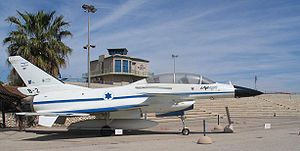TAI GF-20 Berunda: Difference between revisions
| Line 28: | Line 28: | ||
===Airframe=== | ===Airframe=== | ||
===Avionics=== | ===Avionics=== | ||
The Berunda's main area of advancement over its contemporaries was the level of integration of avionics and onboard electronics; it was claimed that the Berundai was "more computerised than any other system in the world". A key innovation was the use of a quadruplex-redundant digital fly-by-wire flight control system, which was co-developed by Parul Asuri and TAI. The Berunda | The Berunda's main area of advancement over its contemporaries was the level of integration of avionics and onboard electronics; it was claimed that the Berundai was "more computerised than any other system in the world". A key innovation was the use of a quadruplex-redundant digital fly-by-wire flight control system, which was co-developed by Parul Asuri and TAI. The Berunda was one of the first operational aircraft to employ fully digital flight controls. | ||
The Berunda's avionics suite is almost entirely of Tenaiite design, and employes a modular design capable of adding upgrades via the Rana ACE-4 mission computer. The Berunda has a bootstrap-type hydraulic system, pressurized by TannaTech pumps providing 207 bars of pressure to the flight surfaces. The electronics are powered by a integrated drive generator, with a SAFT main battery and Albatross standby; Fatal also provided the actuation system. The emergency power unit (EPU) and environmental control system were produced by Sund AiResearch, as was the secondary power system. | The Berunda's avionics suite is almost entirely of Tenaiite design, and employes a modular design capable of adding upgrades via the Rana ACE-4 mission computer. The Berunda has a bootstrap-type hydraulic system, pressurized by TannaTech pumps providing 207 bars of pressure to the flight surfaces. The electronics are powered by a integrated drive generator, with a SAFT main battery and Albatross standby; Fatal also provided the actuation system. The emergency power unit (EPU) and environmental control system were produced by Sund AiResearch, as was the secondary power system. | ||
Revision as of 14:33, 5 August 2020
| GF-20 Berunda | |
|---|---|

| |
| Role | Multirole fighter |
| Manufacturer | Tennai Aerospace Industries |
| First flight | 31 December 1986 |
| Introduction | 18 March 1990 |
| Status | In active service |
| Primary user | Tennai |
| Program cost | US$1.5 billion |
| Unit cost |
$15 million
|
Development
Origins
Testing
Design
Overview
Airframe
Avionics
The Berunda's main area of advancement over its contemporaries was the level of integration of avionics and onboard electronics; it was claimed that the Berundai was "more computerised than any other system in the world". A key innovation was the use of a quadruplex-redundant digital fly-by-wire flight control system, which was co-developed by Parul Asuri and TAI. The Berunda was one of the first operational aircraft to employ fully digital flight controls.
The Berunda's avionics suite is almost entirely of Tenaiite design, and employes a modular design capable of adding upgrades via the Rana ACE-4 mission computer. The Berunda has a bootstrap-type hydraulic system, pressurized by TannaTech pumps providing 207 bars of pressure to the flight surfaces. The electronics are powered by a integrated drive generator, with a SAFT main battery and Albatross standby; Fatal also provided the actuation system. The emergency power unit (EPU) and environmental control system were produced by Sund AiResearch, as was the secondary power system.
Cockpit
All-round pilot vision is provided by a wrap-around windshield and bubble canopy. The Berunda employs a conventional upright seat and central control column. The cockpit employs HOTAS (hands-on-throttle and stick), with a Cheppali wide-angle diffractive optics head up display (HUD) seated on a single El-Op up-front control panel. There are three conventional displays, two of which are color. Display redundancy was ensured by data-sharing between the HMDs. There was an Rana SDC-640 fully computerized onboard UHF radio system and a navigation system which includes the Golkand TINS 1800 advanced inertial navigation system. Aspects such as flexibility and situational awareness were emphasized in the design to reduce pilot workload at high g and in a dense threat environment.
The use of sidestick controller had been discounted for three main reasons: it took too much space on the starboard console; it was difficult for an instructor pilot to monitor his pupil as it was a force transducer; and it would mean that so much as a minor right arm injury would jeopardise the mission. The adoption of a tilted seat was ruled out during development since it would have elevated the pilot's knees, causing a reduction in available panel space, and would also cause the high-g neck and shoulder strain injuries that were common amongst () pilots. The standard practice of providing a second seat for conversion training, by means of reduced fuel or avionics was shunned by TAI. They designed the two-seater as the base model which was then adapted into a single-seater, leaving ample space for avionics growth. It was intended that the first 30 production aircraft would be two-seaters to aid service entry.